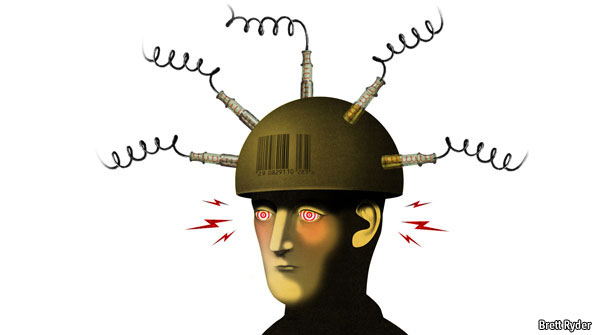Source: The Economist (Schumpeter) September 24, 2011
A marketing guru reveals some of the secrets of his profession

VANCE PACKARD was the Malcolm Gladwell of his day, a journalist with a gift for explaining business to the general public. But in his 1957 classic “The Hidden Persuaders”, he out-Gladwelled Gladwell. The book not only had a perfect title. It also revealed for the first time the psychological tricks that the advertising industry used to make Americans want stuff, instantly transforming the image of America’s advertising executives from glamorous Mad Men into servants of Mephistopheles.
“Brandwashed: Tricks Companies Use to Manipulate Our Minds and Persuade Us to Buy” is an attempt to write a modern version of “The Hidden Persuaders”. Martin Lindstrom cannot write as elegantly as Packard, as his chapter titles (eg, “Buy it, get laid”) make clear. But as a marketing veteran who lists McDonald’s, Procter & Gamble and Microsoft among his former clients, he knows the industry well. It is far more sophisticated than it was in the 1950s, and just as cynical.
Marketers have vastly more information about potential consumers than ever before. Every time you use a loyalty card you surrender personal information. Every time you do a Google search or hit the “like” button on Facebook, you surrender yet more. Google and Facebook protect personal privacy, but they also make money by selling generic information to advertisers. Professional data-miners use electronic data to create a detailed picture of what you have bought in the past (“history sniffing”) and how you bought it (“behaviour sniffing”). They can then draw your attention to products they think you might want to buy in the future. Smartphones can tell you that there is a shop nearby that stocks just the thing you have been looking for.
Marketers milk science for insights. Studies show that music can affect people’s behaviour: shoppers in American department stores who are exposed to piped tunes with a slow tempo spend 18% longer in the store and make 17% more purchases than those who shop in silence. Marketers routinely track shoppers as they make their way around supermarkets and listen in on their conversations at the counter. They also take willing subjects and observe their reactions as they gawp at products.
Marketers are devoting ever more effort to wooing children. The little monsters have a remarkable ability to nag their parents (whom marketers call “wallet-carriers”) into buying what they want. Better still, habits learned in childhood can last a lifetime. So companies bombard children with advertisements from the day they are born. The average American three-year-old can recognise 100 brands. Many can also recite annoying jingles more readily than their times tables. Given a choice between carrots and “McDonald’s carrots”, children hungrily choose the latter. From a company’s point of view, the earlier you hook your customers, the better. Experiments on rats suggest that a taste for junk food can be acquired in the womb.
The most effective marketing tools are often subtle. Kopiko, a confectioner from the Philippines, distributes free chocolates to paediatricians. Apple offers baby-friendly apps such as “Toddler Teasers” and “Baby Fun!”. Gatorade, a drinks-maker, tweets good-luck messages to star athletes. A company called Girls Intelligence Agency employs 40,000 American girls to act as “guerrilla marketers”. It gives them free products and everything they need to organise a slumber party with their friends to try them out. Then it sits back and waits for the buzz to build.
Marketers are also devoting much more effort to marketing to men—or, as Mr Lindstrom puts it, getting men to shop like women. In 1995 only 53% of American men admitted to shopping for themselves. That figure has risen to 75%. Many are buying traditionally “female” products; marketers created a $27 billion “male grooming” industry from nothing. They bombard men with images that were once reserved for women: think of Abercrombie & Fitch’s buff, topless hunks. (Not all hunks are appealing, however. The firm offered to pay a star of “Jersey Shore”, a crass reality show, not to wear its clothes.)
Marketers have long known that the most powerful persuader is peer pressure. What is new is that the data revolution and social media have hugely increased their ability to start “social epidemics”. They create outrageous videos that “go viral”: Quiksilver, a company that sells surfing clothes, produced one about surfers hurling dynamite into a river and then surfing the resulting wave. They turn customers into unwitting marketers: Eagle Outfitters’ Times Square store flashes pictures of anyone who buys its products onto a 25-storey screen and then enjoys free publicity as these instant celebrities send the pictures to their friends. And they create armies of “brand ambassadors”: Apple hires students to become “Apple campus reps” and turns entire sections of university book shops into mini Apple stores.
You can shun, but you can’t hide
Many people imagine they can hide from the hidden persuaders. They skip TV ads and put their faith in customer reviews rather than marketing bilge. They read angry books by Naomi Klein and Morgan Spurlock. They join anti-consumerism groups such as Enough. Yet the marketers have a way of triumphing nonetheless. SAS, a software company, analyses social-media chatter to find people whose online comments influence others; companies can then target these “influentials”. Firms such as Whole Foods turn anti-corporate fads such as organic food into marketing tools. Mr Lindstrom proclaims that he has given up his former profession to become a consumer advocate. But he has forgotten none of his old tricks. To promote his argument, he hired a perfect all-American family to promote goods to their neighbours without their knowledge, in a riff on a recent film, “The Joneses”. The video is on YouTube.

